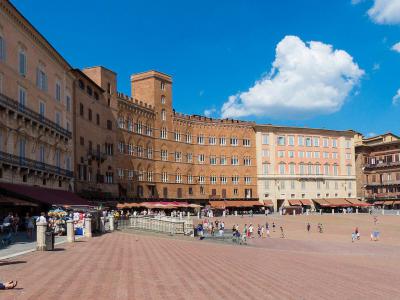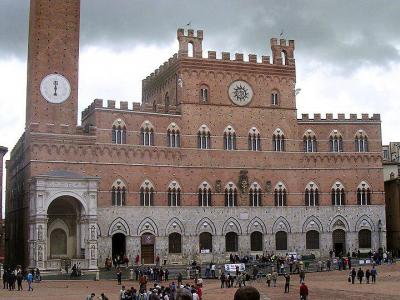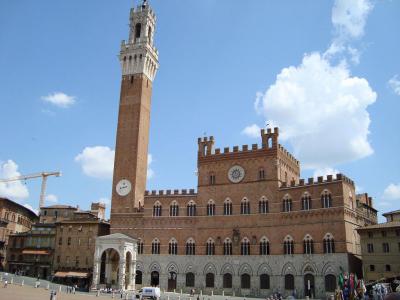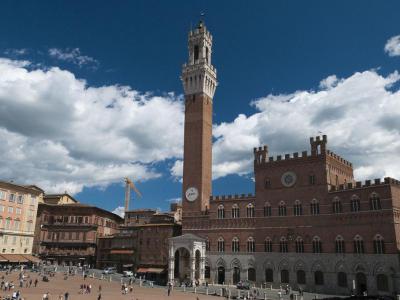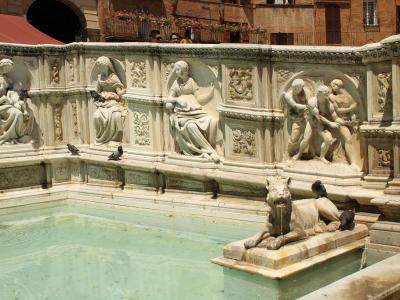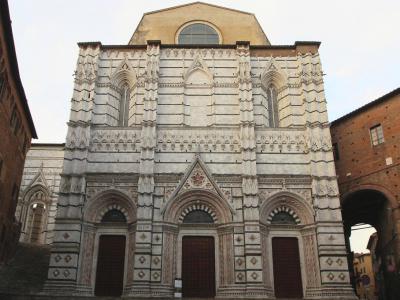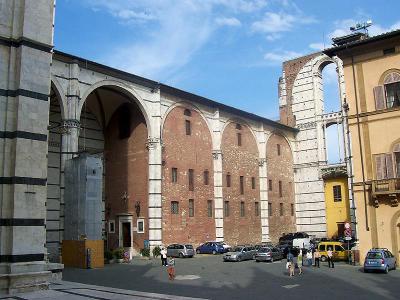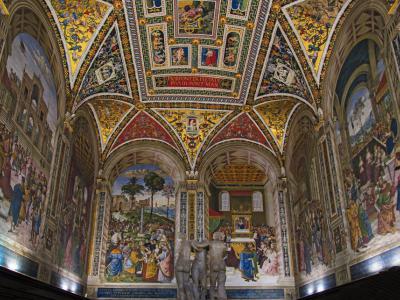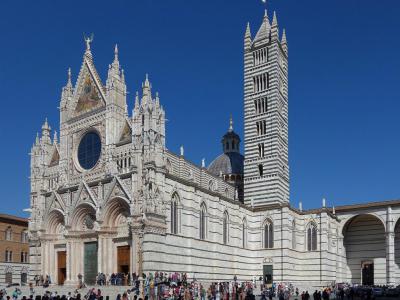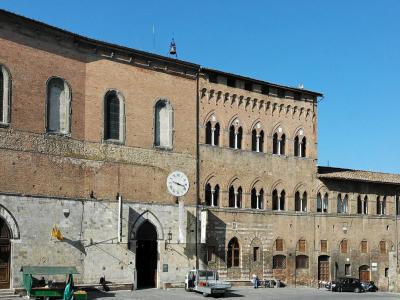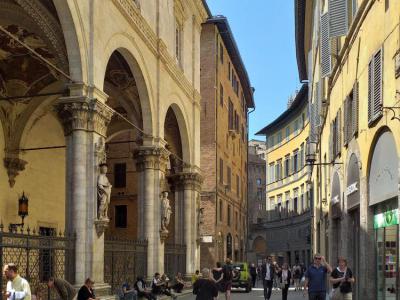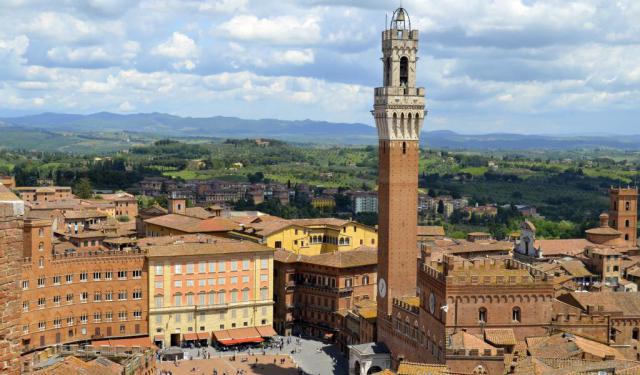
Siena Old Town Walking Tour (Self Guided), Siena
Siena was originally settled by Etruscans of Italy and later settled by Romans, who emulated Etruscan culture and named the city Sena Julia. The Lombard Kings then developed the city. By the 12th century, Siena was self-governing.
Siena established the Council of Nine in 1270. This Council was responsible for a flourishing economy, a focus on art, and a building boom. In 1348, Siena was devastated by the Black Death, losing half of its population and never recovering its previous economic glory. Siena suffered incursions from French and Spanish armies and surrendered to the Spanish in 1555. Finally, in 1861, Siena joined the new Kingdom of Italy.
Siena has a deep religious tradition, with stunning churches, several citizens turned Popes, and revered saints Catherine and Bernardino. Narrow streets, ancient palaces, and historic churches embody Siena's medieval charm.
The Campo Square is the heart of this beautiful city. Admire the unique fishtail paving design. The square is home to many of Siena's most beautiful buildings and landmarks.
The Public Palace was commissioned by the Council of Nine and completed in 1308. This stunning building now houses the Civic Museum on the first floor. In the museum, visitors are treated to gorgeous frescoes depicting various secular scenes. The Mangia Tower is attached to the Public Palace. Visitors who climb to 400 steps are rewarded with a panoramic view of the town. While you explore the Campo Square, don't miss the historical Gaia Fountain.
Irreplaceable artworks are everywhere in Siena. Don't miss the statues, stained glass, and paintings in the Cathedral Treasures Museum or the frescoes in the Piccolomini Library. The Siena Cathedral is filled with artworks by famed artists Michelangelo, Nicola Pisano, Donatello, and Bernini.
Take this self-guided walking tour to experience one of Italy's most beautiful medieval cities.
Siena established the Council of Nine in 1270. This Council was responsible for a flourishing economy, a focus on art, and a building boom. In 1348, Siena was devastated by the Black Death, losing half of its population and never recovering its previous economic glory. Siena suffered incursions from French and Spanish armies and surrendered to the Spanish in 1555. Finally, in 1861, Siena joined the new Kingdom of Italy.
Siena has a deep religious tradition, with stunning churches, several citizens turned Popes, and revered saints Catherine and Bernardino. Narrow streets, ancient palaces, and historic churches embody Siena's medieval charm.
The Campo Square is the heart of this beautiful city. Admire the unique fishtail paving design. The square is home to many of Siena's most beautiful buildings and landmarks.
The Public Palace was commissioned by the Council of Nine and completed in 1308. This stunning building now houses the Civic Museum on the first floor. In the museum, visitors are treated to gorgeous frescoes depicting various secular scenes. The Mangia Tower is attached to the Public Palace. Visitors who climb to 400 steps are rewarded with a panoramic view of the town. While you explore the Campo Square, don't miss the historical Gaia Fountain.
Irreplaceable artworks are everywhere in Siena. Don't miss the statues, stained glass, and paintings in the Cathedral Treasures Museum or the frescoes in the Piccolomini Library. The Siena Cathedral is filled with artworks by famed artists Michelangelo, Nicola Pisano, Donatello, and Bernini.
Take this self-guided walking tour to experience one of Italy's most beautiful medieval cities.
How it works: Download the app "GPSmyCity: Walks in 1K+ Cities" from Apple App Store or Google Play Store to your mobile phone or tablet. The app turns your mobile device into a personal tour guide and its built-in GPS navigation functions guide you from one tour stop to next. The app works offline, so no data plan is needed when traveling abroad.
Siena Old Town Walking Tour Map
Guide Name: Siena Old Town Walking Tour
Guide Location: Italy » Siena (See other walking tours in Siena)
Guide Type: Self-guided Walking Tour (Sightseeing)
# of Attractions: 11
Tour Duration: 1 Hour(s)
Travel Distance: 1.1 Km or 0.7 Miles
Author: violet
Sight(s) Featured in This Guide:
Guide Location: Italy » Siena (See other walking tours in Siena)
Guide Type: Self-guided Walking Tour (Sightseeing)
# of Attractions: 11
Tour Duration: 1 Hour(s)
Travel Distance: 1.1 Km or 0.7 Miles
Author: violet
Sight(s) Featured in This Guide:
- Piazza del Campo (Campo Square)
- Museo Civico (Civic Museum)
- Palazzo Pubblico (Public Palace)
- Torre del Mangia (Mangia Tower)
- Fonte Gaia (Gaia Fountain)
- Battistero di San Giovanni (St. John’s Baptistry)
- Museo dell'Opera del Duomo (Cathedral Treasures Museum) & Facciatone
- Biblioteca Piccolomini (Piccolomini Library)
- Duomo di Siena (Siena Cathedral)
- Santa Maria of Scala Hospital Museum
- Via di Città (City Street)
1) Piazza del Campo (Campo Square) (must see)
The Campo Square on the site where three ancient towns met and where three main roads intersect. The square was designed to be a gathering site where the entire town could meet and celebrate holidays, enjoy games, or attend political events.
The Campo Square features a red brick fishtail design that was laid in 1349. Eight lines of white travertine cut through the red brick, creating nine sections. The nine sections represent the nine ruling governors who maintained peace and prosperity in Siena from 1291-1355.
The sections also represent the folds of the Virgin Mary's cloak. The Virgin Mary was Siena's patron saint and considered Siena's ultimate ruler. The nine sections radiate out from the central water drain in front of the Public Palace.
In 1297, the government created guidelines to ensure buildings had a congruent appearance. Therefore, many gorgeous, harmonious buildings face Campo Square. The most notable building in the square is the medieval Gothic Public Palace which was home to the Government of Nine and now houses the Civic Museum.
The Joyous Fountain was built in 1346, and the intricate marble carvings were added in 1409. Underground tunnels feed the Joyous Fountain.
The Palio di Siena, a popular horse race, is held twice a year. The course runs around the edge of the Campo Square and fans pack the square. The yearly road cycling race Strade Bianche finishes at the square. In addition, the Campo Square hosts various Carnival festivities every February.
Why You Should Visit:
The Campo Square is known as one of the most beautiful medieval squares in Italy. This gorgeously preserved square is the heart and soul of Siena and the perfect place to immerse yourself in Siena's culture and history.
Tips:
Enjoy a glass of wine, gelato, or coffee in one of the many cafes and restaurants. Watch the activity in the square and listen for the tower bells ringing.
The Campo Square features a red brick fishtail design that was laid in 1349. Eight lines of white travertine cut through the red brick, creating nine sections. The nine sections represent the nine ruling governors who maintained peace and prosperity in Siena from 1291-1355.
The sections also represent the folds of the Virgin Mary's cloak. The Virgin Mary was Siena's patron saint and considered Siena's ultimate ruler. The nine sections radiate out from the central water drain in front of the Public Palace.
In 1297, the government created guidelines to ensure buildings had a congruent appearance. Therefore, many gorgeous, harmonious buildings face Campo Square. The most notable building in the square is the medieval Gothic Public Palace which was home to the Government of Nine and now houses the Civic Museum.
The Joyous Fountain was built in 1346, and the intricate marble carvings were added in 1409. Underground tunnels feed the Joyous Fountain.
The Palio di Siena, a popular horse race, is held twice a year. The course runs around the edge of the Campo Square and fans pack the square. The yearly road cycling race Strade Bianche finishes at the square. In addition, the Campo Square hosts various Carnival festivities every February.
Why You Should Visit:
The Campo Square is known as one of the most beautiful medieval squares in Italy. This gorgeously preserved square is the heart and soul of Siena and the perfect place to immerse yourself in Siena's culture and history.
Tips:
Enjoy a glass of wine, gelato, or coffee in one of the many cafes and restaurants. Watch the activity in the square and listen for the tower bells ringing.
2) Museo Civico (Civic Museum) (must see)
The Civic Museum is on the first floor of the Public Palace and features wonderful works of art. The main attraction is different rooms adorned with elaborate frescoes. Don't miss Simone Martini's 1315 Virgin Mary in Majesty and Ambrogio Lorenzetti's Allegories of Good and Bad Government.
On the second floor of the museum, you'll find the Sala del Risorgimento. This 19th-century fresco depicts the reunification period. In the Military Court, father and son artists Spinello and Parri Aretino recreate the life of Pope Alexander III. Pope Alexander III was born in Siena and was Pope from 1159 to 1181.
The Hall of the Council of Clergymen is resplendent with ceiling frescoes completed in 1535 by Domenico Beccafumi. The Chapel entrance hall features frescoes completed in 1415 by Taddeo di Bartolo. The Chapel has frescoes by Giovanni Antonio and contains a wooden choir. In the Vestibule, visitors will marvel at the bronze wolf, a symbol of Siena.
In the Hall of the World Map, you'll find the knock-out Virgin Mary in Majesty fresco by Simone Martini. The Hall of Nine is the room where the Council of Nine met; here, you will find one of the most important secular paintings of the time. The Allegories of Good and Bad Government was painted in 1339 by Ambrogio Lorenzetti and shows Justice, Wisdom, Virtue, and Peace scenes.
On the second floor of the museum, you'll find the Sala del Risorgimento. This 19th-century fresco depicts the reunification period. In the Military Court, father and son artists Spinello and Parri Aretino recreate the life of Pope Alexander III. Pope Alexander III was born in Siena and was Pope from 1159 to 1181.
The Hall of the Council of Clergymen is resplendent with ceiling frescoes completed in 1535 by Domenico Beccafumi. The Chapel entrance hall features frescoes completed in 1415 by Taddeo di Bartolo. The Chapel has frescoes by Giovanni Antonio and contains a wooden choir. In the Vestibule, visitors will marvel at the bronze wolf, a symbol of Siena.
In the Hall of the World Map, you'll find the knock-out Virgin Mary in Majesty fresco by Simone Martini. The Hall of Nine is the room where the Council of Nine met; here, you will find one of the most important secular paintings of the time. The Allegories of Good and Bad Government was painted in 1339 by Ambrogio Lorenzetti and shows Justice, Wisdom, Virtue, and Peace scenes.
3) Palazzo Pubblico (Public Palace) (must see)
The Public Palace was completed in 1308 after being commissioned by the Council of Nine. It is a fine example of traditional Italian medieval architecture. The first floor is light-colored stone, and the upper floors are made of red brick. The facade is slightly curved inwards to reflect the curve of the Campo Square.
In the center of the facade, you will notice a round bronze plate. The Christogram plate was placed in 1425 to honor Saint Bernardino, whose sermons eased social unrest.
The triforate windows are an architectural specialty unique to Siena. The windows are divided with three arches resting on columns. Visitors will also notice the balzana, or coat of arms of the Town Council of Siena.
The attached bell tower, Mangia Tower, was completed in 1348. It stands at 102 meters, the same height as the Siena Cathedral. The height is also equal to the radius of the square. This was deliberate to show that the church and the state had equal power. The Mangia Tower has a gray upper loggia and a red brick base.
The Piazza Chapel was added in 1352 and features marble statues. The lower loggia was added to fulfill a promise that Black Death survivors made to the Holy Virgin. Visitors can climb the Mangia Tower for panaramic views of Siena.
The Public Palace housed the Council of Nine, who were chosen from the general public by lot. The Council of Nine lived in the palace to avoid outside influence and served for just two months before being replaced by the next set of members. The Public Palace also housed the 500 parliamentary members known as the Grand Council.
The internal courtyard is decorated with the coat of arms of families who served on the Council of Nine. Here, you can enter the Civic Museum and see all the world-class frescoes.
Why You Should Visit:
The Public Palace is the crown of Campo Square and a great example of Siena's impressive architecture.
Tips:
You can purchase a combined ticket to climb the Mangia Tower and visit the Civic Museum. Arrive early as the tower tickets sell out fast.
In the center of the facade, you will notice a round bronze plate. The Christogram plate was placed in 1425 to honor Saint Bernardino, whose sermons eased social unrest.
The triforate windows are an architectural specialty unique to Siena. The windows are divided with three arches resting on columns. Visitors will also notice the balzana, or coat of arms of the Town Council of Siena.
The attached bell tower, Mangia Tower, was completed in 1348. It stands at 102 meters, the same height as the Siena Cathedral. The height is also equal to the radius of the square. This was deliberate to show that the church and the state had equal power. The Mangia Tower has a gray upper loggia and a red brick base.
The Piazza Chapel was added in 1352 and features marble statues. The lower loggia was added to fulfill a promise that Black Death survivors made to the Holy Virgin. Visitors can climb the Mangia Tower for panaramic views of Siena.
The Public Palace housed the Council of Nine, who were chosen from the general public by lot. The Council of Nine lived in the palace to avoid outside influence and served for just two months before being replaced by the next set of members. The Public Palace also housed the 500 parliamentary members known as the Grand Council.
The internal courtyard is decorated with the coat of arms of families who served on the Council of Nine. Here, you can enter the Civic Museum and see all the world-class frescoes.
Why You Should Visit:
The Public Palace is the crown of Campo Square and a great example of Siena's impressive architecture.
Tips:
You can purchase a combined ticket to climb the Mangia Tower and visit the Civic Museum. Arrive early as the tower tickets sell out fast.
4) Torre del Mangia (Mangia Tower) (must see)
The Mangia Tower is adjacent to the Public Palace. When the tower was completed, it was the tallest structure in Italy. The tower was built to be exactly the same height as the Siena Cathedral as a sign that the church and the state had equal amount of power. Literally meaning "Tower of the Eater", the name refers to its first bell ringer, Giovanni di Balduccio, nicknamed "profit eater" for his spendthrift tendency or his idleness or gluttony.
The Mangia Tower was built between 1338 and 1348. The upper part was designed by the Sienese Byzantine style artist Lippo Memmi. In 1352, a loggia, dedicated to the Holy Virgin, made of marble with a wooden ceiling, called the Cappella di Piazza, was added by the Sienese survivors of the Black Death. In 1360, a clock was placed in the tower. The present pilaster was a restoration, made in 1378, and the sculptures on the pilaster were carved between 1378 and 1382.
The wooden ceiling of the loggia was replaced with marble between 1461 and 1468. The medieval structure served as a watchtower to warn the citizens of enemy attacks. The design has inspired later many towers located in the UK and the USA. The Mangia Tower is 88 meters high. It is a brick structure with a stone bell hall at the top. A bell, weighing 6,764 kg, was placed here in 1666. A winding staircase, consisting of 400 steps, takes visitors to the top of the tower where they can take in breathtaking views across Siena.
The Mangia Tower was built between 1338 and 1348. The upper part was designed by the Sienese Byzantine style artist Lippo Memmi. In 1352, a loggia, dedicated to the Holy Virgin, made of marble with a wooden ceiling, called the Cappella di Piazza, was added by the Sienese survivors of the Black Death. In 1360, a clock was placed in the tower. The present pilaster was a restoration, made in 1378, and the sculptures on the pilaster were carved between 1378 and 1382.
The wooden ceiling of the loggia was replaced with marble between 1461 and 1468. The medieval structure served as a watchtower to warn the citizens of enemy attacks. The design has inspired later many towers located in the UK and the USA. The Mangia Tower is 88 meters high. It is a brick structure with a stone bell hall at the top. A bell, weighing 6,764 kg, was placed here in 1666. A winding staircase, consisting of 400 steps, takes visitors to the top of the tower where they can take in breathtaking views across Siena.
5) Fonte Gaia (Gaia Fountain) (must see)
The Gaia Fountain is a monumental fountain located opposite the Public Palace on the high side of Campo Square in Siena. Surrounded by fences, the fountain is a protected monument in the city. The Gaia Fountain was designed by local sculptor, Jacopo della Quercia, in 1419, in keeping with the style traditional for Sienese fountains. It consisted of a rectangular basin surrounded by a high parapet on three sides. The parapet was covered with bas reliefs. The bas reliefs depicted the creation of Adam and the flight from the Garden of Eden. The long section has a statue of the Madonna and the Child surrounded by allegories of the virtues.
The fountain was placed on the site of a previous one, created in 1346. It got its name from the celebrations that took place when water flowed from the fountain for the first time. Legend holds that the fountain was met with much joy, and thus the name Gaia or joyous. Others suggest the term Gaia refers to the Latin term for "bride", and that the fountain was dedicated to the bride of God and patron of Siena, the Virgin Mary. The original panels, created by Jacopo della Quercia, fell into disrepair in the 19th century. Tito Sarrochi reproduced the originals, while the old panels were removed and displayed in the loggia of the Public Palace.
The fountain was placed on the site of a previous one, created in 1346. It got its name from the celebrations that took place when water flowed from the fountain for the first time. Legend holds that the fountain was met with much joy, and thus the name Gaia or joyous. Others suggest the term Gaia refers to the Latin term for "bride", and that the fountain was dedicated to the bride of God and patron of Siena, the Virgin Mary. The original panels, created by Jacopo della Quercia, fell into disrepair in the 19th century. Tito Sarrochi reproduced the originals, while the old panels were removed and displayed in the loggia of the Public Palace.
6) Battistero di San Giovanni (St. John’s Baptistry)
The St. John’s Baptistry is a religious building located on the square with the same name, in the back of Siena Cathedral. It was built between 1316 and 1325 by Camaino di Crescentino, a well known Sienese architect, whose son, Tino di Camaino, designed many notable buildings across Italy. The Gothic style façade is unfinished in the upper part, but don't let this fool you.
The interior of St. John’s Baptistry is filled with stunning artwork on the walls and ceilings that inspire awe and wonder at the craftsmanship. Made of bronze, marble and vitreous enamel, the baptismal font is one of the earliest masterpieces of Florentine Renaissance art. It was the work of Jacopo della Quercia. He also designed the shrine made of marble and created the statues of the five prophets in the niches and the statue of St. John the Baptist on the top.
Other pieces of art in the baptistery are by Giovanni di Turino, Ghiberti and Donatello. The frescoes adorning the walls are by the artist Vecchietta. He also painted two pieces found in the apse depicting the "Flagellation" and the "Road to Calvary".
The ticket to St. John’s Baptistry is included in the combination ticket of Siena Cathedral.
The interior of St. John’s Baptistry is filled with stunning artwork on the walls and ceilings that inspire awe and wonder at the craftsmanship. Made of bronze, marble and vitreous enamel, the baptismal font is one of the earliest masterpieces of Florentine Renaissance art. It was the work of Jacopo della Quercia. He also designed the shrine made of marble and created the statues of the five prophets in the niches and the statue of St. John the Baptist on the top.
Other pieces of art in the baptistery are by Giovanni di Turino, Ghiberti and Donatello. The frescoes adorning the walls are by the artist Vecchietta. He also painted two pieces found in the apse depicting the "Flagellation" and the "Road to Calvary".
The ticket to St. John’s Baptistry is included in the combination ticket of Siena Cathedral.
7) Museo dell'Opera del Duomo (Cathedral Treasures Museum) & Facciatone (must see)
The Cathedral Treasures Museum is home to art from the Siena Cathedral. The cathedral was the heart of Siena's artistic, political, and spiritual lives. In 1339, Siena began to expand the cathedral. However, the Black Death decimated over half of the city's population, and work stopped. The incomplete nave is now home to the cathedral's treasures and works of art.
Statues created by Giovannie Pisano, once part of the Siena Cathedral's facade, are on display. Visitors will love the stained glass window from the late 13th century. The stained glass window is 30 square meters and has nine beautiful panels depicting the Virgin Mary, the four Biblical Evangelists, and Siena's four patron saints.
Duccio di Buoninsenga's Virgin Mary in Majesty was completed in 1311, and parts are on display on the second floor. This masterpiece processed from the artist's workshop to the cathedral, as Siena's citizens followed with candles. The altarpiece depicts the Madonna and Child with saints and angels surrounding them. The back piece originally had 46 scenes depicting the lives of the Virgin Mary and Christ. The pieces were broken up in 1711 and are now displayed in museums across the world.
The museum also displays rare manuscripts and a gorgeous collection of paintings spanning from the 13th to the 19th centuries.
The Facciatone provides stunning views of the cathedral, the city's rooftops, the Mangia Tower, and across to Tuscany's countryside. The Facciatone is accesabile from the museum's upstairs floor. To reach the top, intrepid travelers climb 131 steps up a narrow corkscrew stairway.
Statues created by Giovannie Pisano, once part of the Siena Cathedral's facade, are on display. Visitors will love the stained glass window from the late 13th century. The stained glass window is 30 square meters and has nine beautiful panels depicting the Virgin Mary, the four Biblical Evangelists, and Siena's four patron saints.
Duccio di Buoninsenga's Virgin Mary in Majesty was completed in 1311, and parts are on display on the second floor. This masterpiece processed from the artist's workshop to the cathedral, as Siena's citizens followed with candles. The altarpiece depicts the Madonna and Child with saints and angels surrounding them. The back piece originally had 46 scenes depicting the lives of the Virgin Mary and Christ. The pieces were broken up in 1711 and are now displayed in museums across the world.
The museum also displays rare manuscripts and a gorgeous collection of paintings spanning from the 13th to the 19th centuries.
The Facciatone provides stunning views of the cathedral, the city's rooftops, the Mangia Tower, and across to Tuscany's countryside. The Facciatone is accesabile from the museum's upstairs floor. To reach the top, intrepid travelers climb 131 steps up a narrow corkscrew stairway.
8) Biblioteca Piccolomini (Piccolomini Library) (must see)
The Piccolomini Library is located inside the Siena Cathedral. It was built by Pope Pius II's nephew, Francesco Piccolomini. Pope Pius II was formerly the Bishop of Siena. Pope Pius II appointed his nephew to be the Archbishop of Siena, then Cardinal Piccolomini.
Cardinal Piccolomini commissioned the Piccolomini Library in 1502 as a memorial to Pope Pius II. The library was intended to showcase texts assembled by Pope Pius II. Cardinal Piccolomini followed his uncle's path and later became Pope Pius III.
The complete trove of manuscripts was never transferred to the library; however, several hand-painted texts from the 1400s are on display. The main draw of the library is the remarkable frescoes.
The frescoes are the star of the library. The frescoes were created by Pinturicchio and assisted by 21-year-old Raphael. The walls are divided into ten scenes depicting an important part of Pope Pius II's life. Painted columns frame each scene. Each fresco is meticulous, with luxuriously clothed figures and vibrantly colored backgrounds. Scenes include the Pope's time as ambassador to European courts, paying respects to the new Emperor, mediating the marriage of Emporer Frederick III and Eleonora of Aragon, and becoming Cardinal and then Pope.
The fresco at the entrance shows Pope Pius III's coronation. Unfortunately, Pope Pius III died just ten days after his coronation.
In the center of the room, visitors will find a gorgeous copy of The Three Graces. The Three Graces are based on an ancient statue from the Hellenistic Period (fourth to second century BC).
Remember to look up; the ceilings are intricately painted.
Why You Should Visit:
The frescoes are remarkably well-preserved. Art lovers will relish seeing work created by Pinturicchio and young Raphael. The frescoes tell the story of a powerful Siena family, the Piccolomini's, and focus on the life of the most famous Piccolomini, Pope Pius III.
Tips:
There are several hidden gems to search for. Pinturicchio and Raphael painted themselves into the scene showing the canonization of St Catherine. Raphel is wearing red stockings, and Pinturicchio is wearing a red cap. Visitors should also notice the half-moons. The half-moon was the Piccolomini family symbol and is hidden everywhere in the frescoes.
Cardinal Piccolomini commissioned the Piccolomini Library in 1502 as a memorial to Pope Pius II. The library was intended to showcase texts assembled by Pope Pius II. Cardinal Piccolomini followed his uncle's path and later became Pope Pius III.
The complete trove of manuscripts was never transferred to the library; however, several hand-painted texts from the 1400s are on display. The main draw of the library is the remarkable frescoes.
The frescoes are the star of the library. The frescoes were created by Pinturicchio and assisted by 21-year-old Raphael. The walls are divided into ten scenes depicting an important part of Pope Pius II's life. Painted columns frame each scene. Each fresco is meticulous, with luxuriously clothed figures and vibrantly colored backgrounds. Scenes include the Pope's time as ambassador to European courts, paying respects to the new Emperor, mediating the marriage of Emporer Frederick III and Eleonora of Aragon, and becoming Cardinal and then Pope.
The fresco at the entrance shows Pope Pius III's coronation. Unfortunately, Pope Pius III died just ten days after his coronation.
In the center of the room, visitors will find a gorgeous copy of The Three Graces. The Three Graces are based on an ancient statue from the Hellenistic Period (fourth to second century BC).
Remember to look up; the ceilings are intricately painted.
Why You Should Visit:
The frescoes are remarkably well-preserved. Art lovers will relish seeing work created by Pinturicchio and young Raphael. The frescoes tell the story of a powerful Siena family, the Piccolomini's, and focus on the life of the most famous Piccolomini, Pope Pius III.
Tips:
There are several hidden gems to search for. Pinturicchio and Raphael painted themselves into the scene showing the canonization of St Catherine. Raphel is wearing red stockings, and Pinturicchio is wearing a red cap. Visitors should also notice the half-moons. The half-moon was the Piccolomini family symbol and is hidden everywhere in the frescoes.
9) Duomo di Siena (Siena Cathedral) (must see)
Siena Cathedral is one of Italy's most exquisite Cathedrals. The Cathedral was completed in 1263 on the site of a church dating to the 9th century. This stunning Cathedral has a transept, a dome, and a bell tower and features artwork from Italy's most prominent artists.
The dome has a hexagonal base and supporting columns. Famous sculptor Gian Lorenzo Bernini designed the lantern on top of the dome. The bell tower features six bells; the oldest bell was cast in 1149. The Cathedral was built with white and dark-colored marble in alternating stripes. White and black are the colors of Siena and represent the white and black horses of the city's founders, Senius and Aschius.
Giovanni Pisano, Nicola Pisano's son, created the west facade with carved sculptures of the prophets and philosophers. The original sculptures are now housed in the Cathedral Treasures Museum, while copies are displayed in the facade.
The mosaic inlay floor is the Cathedral's prized possession and has been called the most beautiful floor ever made. Fifty-six inlay panels were drawn by various Sienese artists and transposed into the marble mosaic inlay.
The most celebrated Italian artists created artwork on display in the Cathedral. Donatello created a statue of St. John the Baptist in the St. John the Baptist chape. Michelangelo carved four statues, St. Peter, St. Paul, St. Pius, and St. Augustine, for the Piccolomini altar. Gian Lorenzo Bernini carved the statues of St. Mary Magdalen and St. Jerome in the Chapel of the Vow. Nicola Pisano carved the pulpit that can be seen in the north transept.
A copy of Duccio di Boninsegna's stained glass window is on display. The original is in the Cathedral Treasures Museum. Several other notable stained glass works beautify the Cathedral.
The Cathedral Choir features eight wood-carved inlays by Fra Giovanni da Verona. Underneath the choir, a narthex, long filled with rubble, was excavated between 1999 and 2003. The excavation uncovered 13th-century frescoes depicting scenes from the life of Christ.
Why You Should Visit:
The Siena Cathedral is regarded as one of the most beautiful Cathedrals in Italy and shows the pinnacle of Siena's beauty and commitment to artistry. Statues by Donatello, Michelangelo, and Bernini are just some of the artworks on display.
Tips:
Inside the main entrance, there's a sign with a map of the Cathedral's floorplan. Take a photo of this map with your phone, so you don't get lost as you explore the massive Cathedral and take in all the sights.
The Cathedral is open until 7 pm and is less crowded in the early evening. The floor is only uncovered during specific dates; check online to see if the floor is uncovered during your visit.
The dome has a hexagonal base and supporting columns. Famous sculptor Gian Lorenzo Bernini designed the lantern on top of the dome. The bell tower features six bells; the oldest bell was cast in 1149. The Cathedral was built with white and dark-colored marble in alternating stripes. White and black are the colors of Siena and represent the white and black horses of the city's founders, Senius and Aschius.
Giovanni Pisano, Nicola Pisano's son, created the west facade with carved sculptures of the prophets and philosophers. The original sculptures are now housed in the Cathedral Treasures Museum, while copies are displayed in the facade.
The mosaic inlay floor is the Cathedral's prized possession and has been called the most beautiful floor ever made. Fifty-six inlay panels were drawn by various Sienese artists and transposed into the marble mosaic inlay.
The most celebrated Italian artists created artwork on display in the Cathedral. Donatello created a statue of St. John the Baptist in the St. John the Baptist chape. Michelangelo carved four statues, St. Peter, St. Paul, St. Pius, and St. Augustine, for the Piccolomini altar. Gian Lorenzo Bernini carved the statues of St. Mary Magdalen and St. Jerome in the Chapel of the Vow. Nicola Pisano carved the pulpit that can be seen in the north transept.
A copy of Duccio di Boninsegna's stained glass window is on display. The original is in the Cathedral Treasures Museum. Several other notable stained glass works beautify the Cathedral.
The Cathedral Choir features eight wood-carved inlays by Fra Giovanni da Verona. Underneath the choir, a narthex, long filled with rubble, was excavated between 1999 and 2003. The excavation uncovered 13th-century frescoes depicting scenes from the life of Christ.
Why You Should Visit:
The Siena Cathedral is regarded as one of the most beautiful Cathedrals in Italy and shows the pinnacle of Siena's beauty and commitment to artistry. Statues by Donatello, Michelangelo, and Bernini are just some of the artworks on display.
Tips:
Inside the main entrance, there's a sign with a map of the Cathedral's floorplan. Take a photo of this map with your phone, so you don't get lost as you explore the massive Cathedral and take in all the sights.
The Cathedral is open until 7 pm and is less crowded in the early evening. The floor is only uncovered during specific dates; check online to see if the floor is uncovered during your visit.
10) Santa Maria of Scala Hospital Museum (must see)
Santa Maria of Scala was one of Europe's first hospitals. Today a museum, it was once an important civic hospital dedicated to caring for abandoned children, the poor, the sick, and pilgrims. Most of its operating budget was from bequests and donations from the wealthy citizens of Siena. The head of the hospital was the rector who managed the lay brothers responsible for its operation.
According to local legend, it was founded by a shoemaker on the land donated by him and later managed by Siena Cathedral. In the 15th century, the city of Siena took over its management. The old hospital building had interiors covered with frescoes by Sienese masters of which only a few remain today. The windows are covered with the oldest Italian manufactured stained glass dating back to 1288. The museum is the third largest repository of art and sculpture in Siena.
The rooms in the basement house the National Archeological Museum with objects from excavations around Siena. The main ward room that once contained beds for patients has walls covered with frescoes depicting the history of the hospital. There is also an impressive collection of works by Sienese artists in the other rooms. The museum also holds themed temporary exhibitions from time to time.
According to local legend, it was founded by a shoemaker on the land donated by him and later managed by Siena Cathedral. In the 15th century, the city of Siena took over its management. The old hospital building had interiors covered with frescoes by Sienese masters of which only a few remain today. The windows are covered with the oldest Italian manufactured stained glass dating back to 1288. The museum is the third largest repository of art and sculpture in Siena.
The rooms in the basement house the National Archeological Museum with objects from excavations around Siena. The main ward room that once contained beds for patients has walls covered with frescoes depicting the history of the hospital. There is also an impressive collection of works by Sienese artists in the other rooms. The museum also holds themed temporary exhibitions from time to time.
11) Via di Città (City Street)
The City Street is one of the main streets of old Siena. Today it is a pedestrian street that is flanked by many well known historical buildings and home to many shops, restaurants and cafes. The City Street was once called the Shoemakers Street due to the presence of many shops of shoemakers. At one end of the street is a square called the Quattro Cantoni which is the meeting point of the three main streets of the city. In the old days, it was a common practice for the high society of the city to go for an evening stroll on the street.
Of the three main streets of old Siena, the City Street has the most stately and elegant buildings in the city. Among the beautiful buildings along the City Street are: the Patrizi Place that dates back to the 14th century; the music academy at the Chigi-Saracini Palace; the Palace of Papesse, a Florentine renaissance style building that houses a contemporary arts center; the Gothic style Marsili Palace and the Loggia of Mercanzia, the Sienese equivalent of a chamber of commerce.
Today the picturesque pedestrian street is the main shopping and dining destination in Siena.
Of the three main streets of old Siena, the City Street has the most stately and elegant buildings in the city. Among the beautiful buildings along the City Street are: the Patrizi Place that dates back to the 14th century; the music academy at the Chigi-Saracini Palace; the Palace of Papesse, a Florentine renaissance style building that houses a contemporary arts center; the Gothic style Marsili Palace and the Loggia of Mercanzia, the Sienese equivalent of a chamber of commerce.
Today the picturesque pedestrian street is the main shopping and dining destination in Siena.
Walking Tours in Siena, Italy
Create Your Own Walk in Siena
Creating your own self-guided walk in Siena is easy and fun. Choose the city attractions that you want to see and a walk route map will be created just for you. You can even set your hotel as the start point of the walk.
Siena's Palaces Walking Tour
A leisurely stroll through downtown Siena – a designated UNESCO World Heritage Site, full of imperious castles, palaces and other historic buildings – promises an exciting day of discovery and a pleasant experience for architecture buffs.
While most Italian cities have a church on their main square, Siena's famous Piazza Del Campo gathers around the city hall, known as Palazzo Pubblico... view more
Tour Duration: 1 Hour(s)
Travel Distance: 0.7 Km or 0.4 Miles
While most Italian cities have a church on their main square, Siena's famous Piazza Del Campo gathers around the city hall, known as Palazzo Pubblico... view more
Tour Duration: 1 Hour(s)
Travel Distance: 0.7 Km or 0.4 Miles
Medieval Siena Walking Tour
Siena is a beautiful medieval city whose Gothic-era identity, acquired between the 12th and 15th centuries, has been successfully preserved due to the centuries of political and economic irrelevance in the shadow of its grander neighbor Florence. Today's Siena is a cultural gold mine and ideal place to revel in medieval Italy.
No tour of Siena is complete without visiting its heart, the... view more
Tour Duration: 2 Hour(s)
Travel Distance: 3.5 Km or 2.2 Miles
No tour of Siena is complete without visiting its heart, the... view more
Tour Duration: 2 Hour(s)
Travel Distance: 3.5 Km or 2.2 Miles
The Most Popular Cities
/ view all
